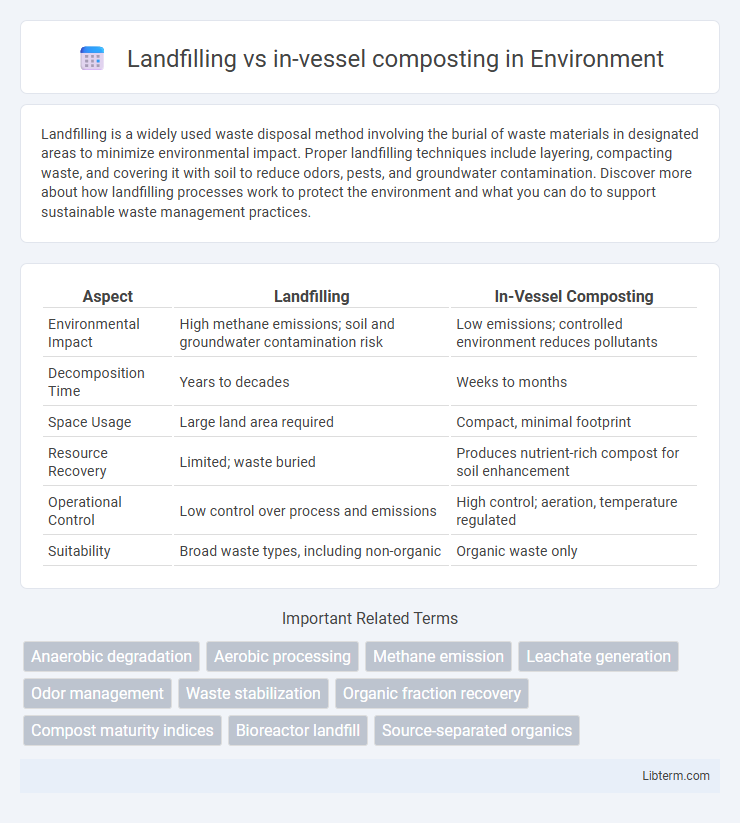Landfilling is a widely used waste disposal method involving the burial of waste materials in designated areas to minimize environmental impact. Proper landfilling techniques include layering, compacting waste, and covering it with soil to reduce odors, pests, and groundwater contamination. Discover more about how landfilling processes work to protect the environment and what you can do to support sustainable waste management practices.
Table of Comparison
| Aspect | Landfilling | In-Vessel Composting |
|---|---|---|
| Environmental Impact | High methane emissions; soil and groundwater contamination risk | Low emissions; controlled environment reduces pollutants |
| Decomposition Time | Years to decades | Weeks to months |
| Space Usage | Large land area required | Compact, minimal footprint |
| Resource Recovery | Limited; waste buried | Produces nutrient-rich compost for soil enhancement |
| Operational Control | Low control over process and emissions | High control; aeration, temperature regulated |
| Suitability | Broad waste types, including non-organic | Organic waste only |
Introduction to Waste Management Methods
Landfilling and in-vessel composting represent two contrasting waste management methods with distinct environmental impacts. Landfilling involves the disposal of waste in designated areas, often leading to long-term methane emissions and potential groundwater contamination. In-vessel composting accelerates organic waste decomposition within controlled environments, reducing greenhouse gases and producing nutrient-rich compost for soil enhancement.
Understanding Landfilling: Process and Impacts
Landfilling involves the controlled burial of waste in designated sites, where organic waste decomposes anaerobically, producing methane, a potent greenhouse gas contributing significantly to climate change. Leachate, a toxic liquid formed by water percolating through waste, poses a major risk to groundwater and soil quality, necessitating advanced containment and treatment systems. The slow degradation rate and large land requirements of landfills contrast with more sustainable waste management options.
What is In-Vessel Composting?
In-vessel composting is a controlled aerobic process where organic waste is enclosed in a vessel to optimize temperature, moisture, and oxygen levels for rapid decomposition. Unlike landfilling, which buries waste and produces methane emissions, in-vessel composting accelerates the breakdown of biodegradable materials into nutrient-rich compost within weeks. This method reduces landfill space usage and mitigates environmental pollution by capturing organic waste in a contained environment.
Environmental Impacts of Landfilling
Landfilling generates significant methane emissions, a potent greenhouse gas contributing to climate change, due to anaerobic decomposition of organic waste. Leachate from landfills poses risks of groundwater contamination, threatening ecosystems and human health through toxic pollutants. In contrast, in-vessel composting offers controlled aerobic decomposition, reducing harmful emissions and producing nutrient-rich soil amendments with minimal environmental impact.
Environmental Benefits of In-Vessel Composting
In-vessel composting significantly reduces methane emissions compared to landfilling by providing aerobic conditions that promote organic matter decomposition without producing greenhouse gases. This controlled environment also minimizes leachate generation and odor issues, leading to lower soil and water contamination risks. Enhanced nutrient recovery from in-vessel composting supports sustainable agriculture by producing high-quality compost, thereby reducing the need for chemical fertilizers.
Cost Comparison: Landfilling vs In-Vessel Composting
Landfilling generally incurs lower initial capital costs compared to in-vessel composting but results in higher long-term expenses due to landfill tipping fees, methane gas management, and environmental remediation. In-vessel composting requires higher upfront investment for equipment and controlled environment systems but offers reduced operational costs through faster processing times and potential revenue from compost sales. Overall, in-vessel composting presents a more cost-effective solution in the long run by minimizing landfill liabilities and generating valuable organic end-products.
Land Usage and Space Requirements
Landfilling requires significantly more land area compared to in-vessel composting due to the need for large, open disposal sites that accommodate extensive waste volumes over time. In-vessel composting offers a compact, controlled environment, drastically reducing the spatial footprint by containing organic waste within enclosed reactors. Efficient space utilization in in-vessel systems enables higher waste processing capacity per unit area, making it ideal for urban or land-scarce regions.
Odor and Emission Control
Landfilling generates significant methane emissions and strong odors due to anaerobic decomposition of organic waste, posing environmental and health risks. In-vessel composting offers superior odor and emission control by maintaining aerobic conditions within a sealed system, reducing methane production and minimizing off-gassing of volatile compounds. This controlled environment enhances biodegradation efficiency while mitigating harmful emissions typically associated with open landfill sites.
Regulatory and Policy Considerations
Landfilling is highly regulated due to methane emissions and leachate management under policies like the U.S. EPA's Subtitle D and the EU Landfill Directive, requiring strict monitoring and control measures. In-vessel composting faces regulatory frameworks targeting pathogen reduction, odor control, and carbon emissions, often governed by solid waste and renewable energy policies promoting sustainable organic waste processing. Incentives such as tax credits and grants for in-vessel composting enhance compliance and support zero-waste initiatives, contrasting with landfill tipping fees and environmental penalties that drive waste diversion efforts.
Future Trends in Sustainable Waste Management
Landfilling is increasingly challenged by environmental regulations and methane emissions, driving a shift toward in-vessel composting, which offers controlled aerobic decomposition and reduced landfill dependency. Future trends emphasize integrating advanced sensor technology and automation in in-vessel composting to optimize microbial activity and accelerate organic waste breakdown. Emerging policies prioritize circular economy principles, promoting in-vessel composting as a scalable solution for organic waste valorization and carbon footprint reduction.
Landfilling Infographic

 libterm.com
libterm.com